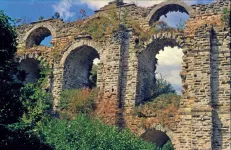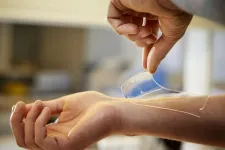The Aqueduct of Constantinople: Managing the longest water channel of the ancient world
Double water channels may have been used to maintain the system while enabling constant operation
2021-05-11
(Press-News.org) Aqueducts are very impressive examples of the art of construction in the Roman Empire. Even today, they still provide us with new insights into aesthetic, practical, and technical aspects of construction and use. Scientists at Johannes Gutenberg University Mainz (JGU) investigated the longest aqueduct of the time, the 426-kilometer-long Aqueduct of Valens supplying Constantinople, and revealed new insights into how this structure was maintained back in time. It appears that the channels had been cleaned of carbonate deposits just a few decades before the site was abandoned.
The late Roman aqueduct provided water for the population of Constantinople
The Roman Empire was ahead of its time in many ways, with a strong commitment to build infrastructure for its citizens which we still find fascinating today. This includes architecturally inspiring temples, theaters, and amphitheaters, but also a dense road network and impressive harbors and mines. "However, the most ground-breaking technical achievement of the Roman Empire lies in its water management, particularly its long-distance aqueducts that delivered water to cities, baths, and mines," said Dr. Gül Sürmelihindi from the Geoarchaeology group at Mainz University. Aqueducts were not a Roman invention, but in Roman hands these long-distance aqueducts developed further and extensively diffused throughout one of the largest empires in history.
Almost every city in the Roman Empire had an ample supply of fresh running water, in some cases actually with a larger volume than is the case today. "These aqueducts are mostly known for their impressive bridges, such as the Pont du Gard in southern France, which are still standing today after two millennia. But they are most impressive because of the way problems in their construction were solved, which would be daunting even for modern engineers," said JGU Professor Cees Passchier. More than 2,000 long-distance Roman aqueducts are known to date, and many more are awaiting discovery. The study undertaken by Dr. Gül Sürmelihindi and her research team focuses on the most spectacular late-Roman aqueduct, the water supply lines of Constantinople, now Istanbul in present-day Turkey.
Carbonate deposits provide insights into Byzantine water management
In AD 324, the Roman Emperor Constantine the Great made Constantinople the new capital of the Roman Empire. Although the city lies at the geopolitically important crossroads of land routes and seaways, fresh water supply was a problem. A new aqueduct was therefore built to supply Constantinople from springs 60 kilometers to the west. As the city grew, this system was expanded in the 5th century to springs that lie even 120 kilometers from the city in a straight line. This gave the aqueduct a total length of at least 426 kilometers, making it the longest of the ancient world. The aqueduct consisted of vaulted masonry channels large enough to walk through, built of stone and concrete, 90 large bridges, and many tunnels up to 5 kilometers long.
Sürmelihindi and her team studied carbonate deposits from this aqueduct, i.e., the limescale that formed in the running water, which can be used to obtain important information about water management and the palaeoenvironment at that time. The researchers found that the entire aqueduct system only contained thin carbonate deposits, representing about 27 years of use. From the annals of the city, however, it is known that the aqueduct system worked for more than 700 years, until at least the 12th century. "This means the entire aqueduct must have been maintained and cleaned of deposits during the Byzantine Empire, even shortly before it ceased working," explained Sürmelihindi. Carbonate deposits can block the entire water supply and have to be removed from time to time.
Double construction over 50 kilometers was likely built for maintenance
Although the aqueduct is late Roman in origin, the carbonate found in the channel is from the Byzantine Middle Ages. This made the researchers think about possible cleaning and maintenance strategies - because cleaning and repairing a channel of 426 kilometers implies that it cannot be used for weeks or months, while the city population depends on its water supply. They then found that 50 kilometers of the central part of the water system is constructed double, with one aqueduct channel above the other, crossing on two-story bridges. "It is very likely that this system was set up to allow for cleaning and maintenance operations," said Passchier. "It would have been a costly but practical solution."
Unfortunately for the research team, it is no longer possible to study the exact operation of the system. One of the most imposing bridges, that of Ballıgerme, was blown up with dynamite in 2020 by treasure hunters who erroneously believed they could find gold in the ruins.
INFORMATION:
Images:
https://download.uni-mainz.de/presse/09_geowiss_tektonik_aquaedukt_valens_01.jpg
The 426-kilometer-long aqueduct system of Constantinople
ill./©: Cees Passchier
https://download.uni-mainz.de/presse/09_geowiss_tektonik_aquaedukt_valens_02.jpg
The Ballıgerme Bridge, part of the aqueduct system of Constantinople, which was destroyed by treasure hunters.
photo/©: Jim Crow
https://download.uni-mainz.de/presse/09_geowiss_tektonik_aquaedukt_valens_03.jpg
The two-story Kurşunlugerme Bridge, part of the aqueduct system of Constantinople: Two water channels passed over this bridge - one above the other.
photo/©: Jim Crow
https://download.uni-mainz.de/presse/09_geowiss_tektonik_aquaedukt_valens_04.jpg
Carbonate deposit from the aqueduct system of Constantinople showing around 25 annual layers
photo/©: Cees Passchier
https://download.uni-mainz.de/presse/09_geowiss_tektonik_aquaedukt_valens_05.jpg
Dr. Gül Sürmelihindi in the main water channel of the 426-kilometer-long aqueduct system of Constantinople
photo/©: Cees Passchier
Related links:
https://www.geosciences.uni-mainz.de/tectonics-structural-geology-group/ - Tectonics and Structural Geology group at the JGU Institute of Geosciences ;
https://www.geosciences.uni-mainz.de/geoarchaeology/ - Geoarchaeology group at the JGU Institute of Geosciences
https://www.geosciences.uni-mainz.de/ - JGU Institute of Geosciences
Read more:
https://www.uni-mainz.de/presse/aktuell/12510_ENG_HTML.php - press release "The hydraulics of the world's first industrial plant: a unique construction in the Barbegal water mills" (13 Nov. 2020)
[Attachments] See images for this press release:

ELSE PRESS RELEASES FROM THIS DATE:
2021-05-11
Researchers at Chalmers University of Technology, Sweden, have developed a new material that prevents infections in wounds - a specially designed hydrogel, that works against all types of bacteria, including antibiotic-resistant ones. The new material offers great hope for combating a growing global problem.
The World Health Organization describes antibiotic-resistant bacteria as one of the greatest threats to global health. To deal with the problem, there needs to be a shift in the way we use antibiotics, and new, sustainable medical technologies must be developed.
"After testing our new hydrogel on different types of bacteria, we observed a high level of effectiveness, including against those ...
2021-05-11
In some countries of the WHO European Region, 1 in 3 children aged 6 to 9 years is living with overweight or obesity. Mediterranean countries have the highest rates of obesity, but the situation there is starting to improve.
These are some of the findings of a new WHO European Childhood Obesity Surveillance Initiative (COSI) report on the fourth round of data collection (2015-2017), presented at this week's European Congress on Obesity (held online this year). The report gives the latest data available on 6- to 9-year-olds in 36 countries in the region. A questionnaire collecting ...
2021-05-11
New research presented at this year's European Congress on Obesity (held online, 10-13 May) shows that fat around the waist (abdominal obesity) is more important than general obesity as shown by body mass index (BMI) in predicting the severity of chest X-ray results in patients with COVID-19. The study is by Dr Alexis Elias Malavazos, I.R.C.C.S.Policlinico San Donato, San Donato Milanese, Italy, and colleagues.
Previous research has established that both chest x-ray (CXR) severity score and obesity are predictive risk factors for COVID-19 hospital admission. However, the relationship between abdominal obesity and CXR severity score is not fully explored. This retrospective cohort study analysed the association of different methods of measuring obesity, ...
2021-05-11
New research presented at this year's European Congress on Obesity (held online, 10-13 May) reveals an association between increasing body mass index (BMI) and the risk of testing positive SARS-CoV-2, the virus which causes COVID-19. The study is by Dr Hadar Milloh-Raz, The Chaim Sheba Medical Center, Tel-HaShomer, Ramat-Gan, Israel, and colleagues.
Obesity-related factors, including changes to the innate and adaptive immune systems brought on by excess weight, are believed to be associated with an increased risk of contracting various viral diseases. ...
2021-05-11
A new study published in The Lancet Infectious Diseases journal has found that the risk of delayed acute complications after non-hospitalised SARS-CoV-2 infection is low, but persistent symptoms in this group could lead to increased visits to general practitioners or outpatient clinics in the six months following infection. The study assessed only those complications that led to contact with hospitals.
Researchers assessed the risk of initiating medication and receiving a hospital diagnosis for a new condition by comparing individuals who tested positive via a PCR test for SARS-CoV-2 with individuals who had a negative test during the first wave of the pandemic in Denmark. Results found SARS-CoV-2 positive individuals ...
2021-05-11
Antibiotic resistance in E. coli has been steadily increasing since the early 2000s despite attempts to control it, a new study suggests. In the biggest genomic survey of E. coli to date, that took more than 16 years in Norway, researchers have successfully tracked the spread of antibiotic resistant genes and have shown that these genes are being transferred between E. coli strains.
Researchers from the Wellcome Sanger Institute and University of Oslo have tracked multidrug resistance in Norway and compared this to a previous study from the UK. They found that ...
2021-05-11
As more private data is stored and shared digitally, researchers are exploring new ways to protect data against attacks from bad actors. Current silicon technology exploits microscopic differences between computing components to create secure keys, but artificial intelligence (AI) techniques can be used to predict these keys and gain access to data. Now, Penn State researchers have designed a way to make the encrypted keys harder to crack.
Led by Saptarshi Das, assistant professor of engineering science and mechanics, the researchers used graphene -- a layer of carbon one atom thick -- to develop a novel low-power, scalable, reconfigurable hardware security device with significant resilience ...
2021-05-10
According to the International Whaling Commission, whale-watching tourism generates more than $2.5 billion a year. After the COVID-19 pandemic, this relatively safe outdoor activity is expected to rebound. Two new studies funded by a collaborative initiative between the Smithsonian Tropical Research Institute (STRI) in Panama and Arizona State University (ASU) show how science can contribute to whale watching practices that ensure the conservation and safety of whales and dolphins.
"The Smithsonian's role is to provide scientific advice to policy makers as they pioneer management strategies to promote whale conservation," said STRI marine biologist, Hector Guzmán, whose previous work led the International Maritime Organization to establish ...
2021-05-10
Conducting a discussion in a noisy place can be challenging when other conversations and background noises interfere with our ability to focus attention on our conversation partner. How the brain deals with the abundance of sounds in our environments, and prioritizes among them, has been a topic of debate among cognitive neuroscientists for many decades.
Often referred to as the "Cocktail Party Problem", its central question focuses on whether we can absorb information from a few speakers in parallel, or whether we are limited to understanding speech from only one speaker at a time.
One ...
2021-05-10
Chemotherapy can induce a painful peripheral neuropathy (CIPN), a chronic condition and common adverse effect for cancer patients undergoing treatment. Researchers at University of California San Diego School of Medicine, with colleagues elsewhere, have used a mouse model to demonstrate the pivotal role of cholesterol in CIPN, and proposed a novel therapeutic approach to reverse it.
The findings are published in the May 10, 2021, online issue of the Journal of Experimental Medicine.
The study was a collaboration between the laboratories of senior study author Yury Miller, MD, PhD, professor of medicine, and Tony Yaksh, PhD, professor of anesthesiology and pharmacology, both at UC San Diego School of Medicine. ...
LAST 30 PRESS RELEASES:
[Press-News.org] The Aqueduct of Constantinople: Managing the longest water channel of the ancient world
Double water channels may have been used to maintain the system while enabling constant operation



